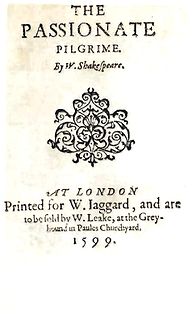Thomas Judson (fl. 1584-1600) was an Elizabethan printer, best known for printing William Jaggard's first two editions of The Passionate Pilgrim (1599), which Jaggard attributed to William Shakespeare. [1]
Floruit, abbreviated fl., Latin for "he/she flourished", denotes a date or period during which a person was known to have been alive or active. In English, the word may also be used as a noun indicating the time when someone "flourished".

The Elizabethan era is the epoch in the Tudor period of the history of England during the reign of Queen Elizabeth I (1558–1603). Historians often depict it as the golden age in English history. The symbol of Britannia was first used in 1572, and often thereafter, to mark the Elizabethan age as a renaissance that inspired national pride through classical ideals, international expansion, and naval triumph over Spain. The historian John Guy (1988) argues that "England was economically healthier, more expansive, and more optimistic under the Tudors" than at any time in a thousand years.
William Jaggard was an Elizabethan and Jacobean printer and publisher, best known for his connection with the texts of William Shakespeare, most notably the First Folio of Shakespeare's plays. Jaggard's shop was "at the sign of the Half-Eagle and Key in Barbican."
Thomas obtained his freedom of the Company by patrimony in January 1581. He was a son of the very prominent Tudor printer John Judson, Stationer in London from c. 1542 until his death in 1589. John was already a senior member of the Worshipful Company of Stationers at its incorporation by Queen Mary in 1557, and was Warden of the Company in 1560-61, 1562-63 and 1570-71, and Master of the Company in 1587-88. [2] In 1569 John Judson operated from the Sign of the Hedghogg in Paul's Churchyard. [3] In his will of 4 May 1588 John left his stock of money held by the Stationers for partnerships to his widow Alice for life, and then to descend to his son Thomas (notwithstanding that Thomas was the second-named of his two sons, and both were to be his Overseers). [4] On 6 May 1592 a dinner for Mistress Judson was held at Stationers' Hall, for which Thomas contributed forty shillings. [5]

Mary I, also known as Mary Tudor, was the Queen of England and Ireland from July 1553 until her death. She is best known for her aggressive attempt to reverse the English Reformation, which had begun during the reign of her father, Henry VIII. The executions that marked her pursuit of the restoration of Roman Catholicism in England and Ireland led to her denunciation as "Bloody Mary" by her Protestant opponents.
In business Thomas Judson was the partner of John Windet. They were in joint occupation of a house called the White Bear in Addle or Addling Hill, near Baynard's Castle, near to, or the same as, premisses later occupied by the printer Valentine Simmes. [6] In early 1600 he sold his business to the printer John Harrison III. [7]

John Windet was an English printer, notable for his music publications. He was a close business associate of fellow printer John Wolfe. After 1591, Wolfe ceased printing the lucrative metrical psalter of Thomas Sternhold and John Hopkins, and Windet succeeded him in becoming the sole printer of the work for patent-holder Richard Day. At some point, Windet succeeded Wolfe as London's City Printer. Wolfe passed on some of his printing ornaments to Windet after he decided to stop printing and focus solely on publishing in 1594. On Wolfe's death in 1601, Windet was appointed administrator of his estate.
Valentine Simmes was an Elizabethan era and Jacobean era printer; he did business in London, "on Adling Hill near Bainard's Castle at the sign of the White Swan." Simmes has a reputation as one of the better printers of his generation, and was responsible for several quartos of Shakespeare's plays. [See: Early texts of Shakespeare's works.]







